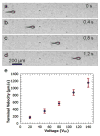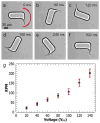Acoustic actuation of bioinspired microswimmers
- PMID: 27991641
- PMCID: PMC5465869
- DOI: 10.1039/c6lc01272h
Acoustic actuation of bioinspired microswimmers
Abstract
Acoustic actuation of bioinspired microswimmers is experimentally demonstrated. Microswimmers are fabricated in situ in a microchannel. Upon acoustic excitation, the flagellum of the microswimmer oscillates, which in turn generates linear or rotary movement depending on the swimmer design. The speed of these bioinspired microswimmers is tuned by adjusting the voltage amplitude applied to the acoustic transducer. Simple microfabrication and remote actuation are promising for biomedical applications.
Figures





References
-
- Mijalkov M, Volpe G. Soft Matter. 2013;9:6376.
-
- Bertin N, Spelman TA, Stephan O, Gredy L, Bouriau M, Lauga E, Marmottant P. Phys Rev Appl. 2015;4:64012.
-
- Volpe G, Buttinoni I, Vogt D, Kümmerer HJ, Bechinger C. Soft Matter. 2011;7:8810.
Publication types
MeSH terms
Grants and funding
LinkOut - more resources
Full Text Sources
Other Literature Sources

